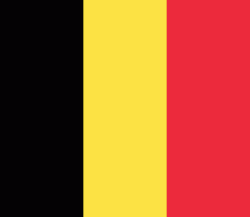Auderghem (Oudergem)
Auderghem (former Dutch spelling, now used in French; pronounced ) or Oudergem is one of the 19 municipalities of the Brussels-Capital Region (Belgium).
Located to the southeast of the region, along the Woluwe valley and at the entrance to the Sonian Forest (French: Forêt de Soignes, Dutch: Zoniënwoud), the municipality has an environmental advantage. Despite large roads slicing through and the increasing traffic, it has been able to preserve a relatively important part of its natural and historic legacy: the creeks, the Red Cloister Abbey and its art centre, the Priory of Val-Duchesse, the Château of Three Fountains (French: Trois Fontaines, Dutch: Drie Fonteinen), the Château of Saint Anne, and the remarkable Chapel of Saint Anne.
Auderghem is adjacent to the municipalities of Etterbeek, Ixelles, Woluwe-Saint-Pierre, and Watermael-Boitsfort. In common with all of Brussels’ municipalities, it is legally bilingual (French–Dutch).
The municipality is governed by its 16th mayor, Didier Gosuin (FDF).
Three forest villages (Auderghem, Watermael, and Boitsfort-Bosvoorde), were one for centuries. In 1794, the soldiers of the French Revolution decided to separate these into three distinct municipalities. In 1811, Napoleon decided to reunite the three villages, by imperial decree, into a single administrative entity. But Auderghem was withdrawn from this union by royal act, leaving Watermael-Boitsfort on its own. Thus, Auderghem became an independent municipality in 1863, with only 1,600 inhabitants.
With the construction of the rail line linking Brussels and Tervuren as well as, in 1910, the construction of Boulevard du Souverain/Vorstlaan, modernisation came to the municipality and the population grew quickly.
In 1956, Paul Henri Spaak lead the Intergovernmental Conference on the Common Market and Euratom at the Château of Val-Duchesse in Auderghem, which prepared the Treaties of Rome in 1957 and the foundation of the European Economic Community and Euratom in 1958.
Located to the southeast of the region, along the Woluwe valley and at the entrance to the Sonian Forest (French: Forêt de Soignes, Dutch: Zoniënwoud), the municipality has an environmental advantage. Despite large roads slicing through and the increasing traffic, it has been able to preserve a relatively important part of its natural and historic legacy: the creeks, the Red Cloister Abbey and its art centre, the Priory of Val-Duchesse, the Château of Three Fountains (French: Trois Fontaines, Dutch: Drie Fonteinen), the Château of Saint Anne, and the remarkable Chapel of Saint Anne.
Auderghem is adjacent to the municipalities of Etterbeek, Ixelles, Woluwe-Saint-Pierre, and Watermael-Boitsfort. In common with all of Brussels’ municipalities, it is legally bilingual (French–Dutch).
The municipality is governed by its 16th mayor, Didier Gosuin (FDF).
Three forest villages (Auderghem, Watermael, and Boitsfort-Bosvoorde), were one for centuries. In 1794, the soldiers of the French Revolution decided to separate these into three distinct municipalities. In 1811, Napoleon decided to reunite the three villages, by imperial decree, into a single administrative entity. But Auderghem was withdrawn from this union by royal act, leaving Watermael-Boitsfort on its own. Thus, Auderghem became an independent municipality in 1863, with only 1,600 inhabitants.
With the construction of the rail line linking Brussels and Tervuren as well as, in 1910, the construction of Boulevard du Souverain/Vorstlaan, modernisation came to the municipality and the population grew quickly.
In 1956, Paul Henri Spaak lead the Intergovernmental Conference on the Common Market and Euratom at the Château of Val-Duchesse in Auderghem, which prepared the Treaties of Rome in 1957 and the foundation of the European Economic Community and Euratom in 1958.
Map - Auderghem (Oudergem)
Map
Country - Belgium
 |
 |
| Flag of Belgium | |
Belgium is a sovereign state and a federal constitutional monarchy with a parliamentary system. Its institutional organization is complex and is structured on both regional and linguistic grounds. It is divided into three highly autonomous regions: the Flemish Region (Flanders) in the north, the Walloon Region (Wallonia) in the south, and the Brussels-Capital Region. Brussels is the smallest and most densely populated region, as well as the richest region in terms of GDP per capita. Belgium is also home to two main linguistic communities: the Flemish Community, which constitutes about 60 percent of the population, and the French Community, which constitutes about 40 percent of the population. A small German-speaking Community, numbering around one percent, exists in the East Cantons. The Brussels-Capital Region is officially bilingual in French and Dutch, although French is the dominant language.
Currency / Language
| ISO | Currency | Symbol | Significant figures |
|---|---|---|---|
| EUR | Euro | € | 2 |
| ISO | Language |
|---|---|
| NL | Dutch language |
| FR | French language |
| DE | German language |















